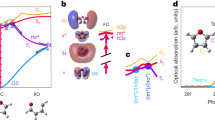Abstract
WHEN β or γ rays are absorbed in matter, sparse tracks of ion pairs are produced: the secondary electrons sometimes have enough energy to produce further ion pairs in small clusters. Distributions of cluster size in a cloud chamber were measured by Wilson as long ago as 1923 (ref. 1); reinterpretation2 of his and other results shows that nearly two thirds of the ion pairs occur in clusters. Similar behaviour should occur in other phases, but little is yet known of the role of clusters in radiolysis. In hydrocarbons, the geminate recombination of radical ions is a major process: most theoretical descriptions have dealt only with single ion pairs3. Since most of the ion pairs recombine very quickly, the clusters will rapidly become single pairs, so the approximation is probably quite good for scavenging studies. If we consider recombination products, especially the yields of singlet and triplet excited states, cluster formation must be taken into account4.
This is a preview of subscription content, access via your institution
Access options
Subscribe to this journal
Receive 51 print issues and online access
$199.00 per year
only $3.90 per issue
Buy this article
- Purchase on Springer Link
- Instant access to full article PDF
Prices may be subject to local taxes which are calculated during checkout
Similar content being viewed by others
References
Wilson, C. T. R. Proc. R. Soc. A 104, 192–212 (1923).
Ore, A. & Larsen, A. Radiat. Res. 21, 331–338 (1964).
Hummel, A. in Advances in Radiation Chemistry (eds Burton, M. & Magee, J.) 4, 1–102 (Wiley, New York, 1974).
Magee, J. L. & Huang, J.-T. J. J. phys. Chem. 76, 3801–3805 (1972).
Baxendale, J. H. & Wardman, P. Trans. Faraday Soc. 67, 2997–3007 (1971).
Thomas, J. K. Int. J. Radiat. phys. Chem. 8, 1–12 (1976).
Salmon, G. A. Int. J. Radiat. phys. Chem. 8, 13–32 (1976).
Brocklehurst, B. Nature 221, 921–3 (1969).
Brocklehurst, B. J. chem. Soc. Faraday Trans. II, 72, 1869–1884 (1976).
Atkins, P. W. & Lambert, T. P. Molec. Phys. 32, 1151–1162 (1976).
Bollinger, L. M. & Thomas, G. E. Rev. Sci. Instr. 32, 1044–1050 (1961).
Dixon, R. S., Gardy, E. M., Lopata, V. J. & Sargent, F. P. Chem. Phys. Lett. 30, 463–464 (1975).
Walter, L. & Lipsky, S. Int. J. Radiat. phys. Chem. 7, 175–182 (1975).
Walter, L., Hirayama, F. & Lipsky, S. Int. J. Radiat. phys. Chem. 8, 237–246 (1976).
Author information
Authors and Affiliations
Rights and permissions
About this article
Cite this article
BROCKLEHURST, B. Ion-pair clusters and excited-state yields in radiolysis. Nature 265, 613–614 (1977). https://doi.org/10.1038/265613a0
Received:
Accepted:
Issue Date:
DOI: https://doi.org/10.1038/265613a0
Comments
By submitting a comment you agree to abide by our Terms and Community Guidelines. If you find something abusive or that does not comply with our terms or guidelines please flag it as inappropriate.



